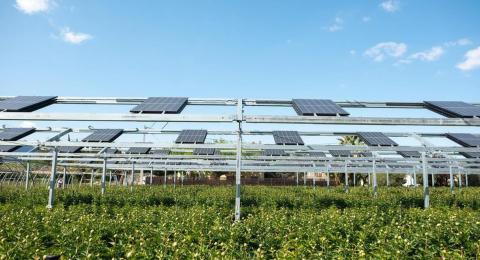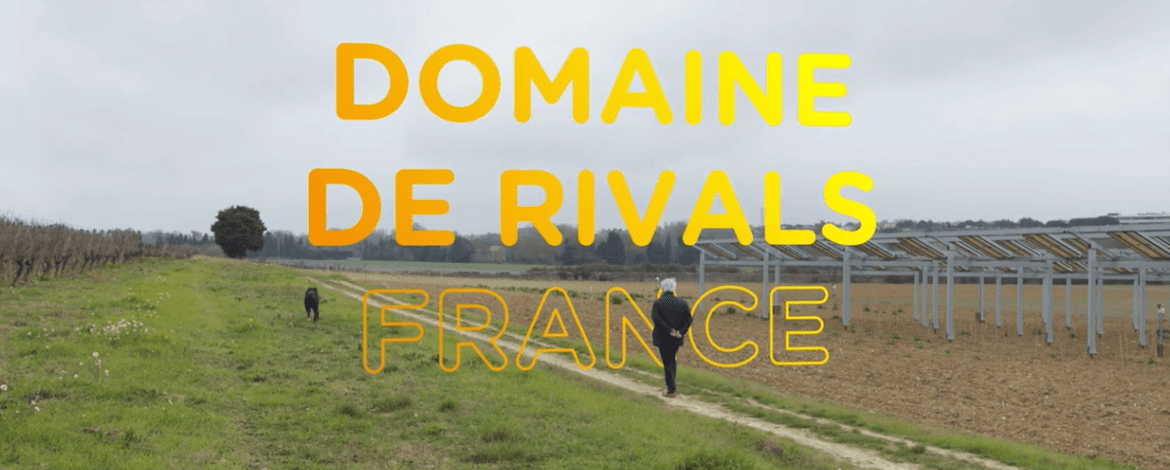18/10/2023 News
Agrivoltaics: cultivating solar energy to build a more sustainable future
What exactly is agrivoltaics?
Agrivoltaics, which is sometimes abbreviated to agriPV, combines agricultural production activities and solar energy generation using solar photovoltaic panels on the same arable land. The legal definition for agrivoltaic facilities also stipulates that they must make a lasting contribution to establishing, maintaining or developing agricultural production. This new synergy means that farmers can add clean energy production to their core activities and enjoy additional revenue streams.
The solar panels create a microclimate (shade, wind, temperature, humidity, etc.) that can be beneficial to crops, which can grow while sheltered from the elements. Several types of crops can benefit from this innovative process and its wealth of advantages.
Agrivoltaics, an innovative and promising solution
Agrivoltaics promises to offer innovation, sustainability and responsibility. This ingenious technology, which combines agriculture with solar energy, is shaping up to be a promising solution for meeting agricultural, energy and environmental challenges. By allowing solar photovoltaic panels to be installed on cropland or fitted on agricultural facilities, agrivoltaics helps maintain the resources needed to ensure food security while promoting the transition to low-carbon energy sources. TotalEnergies, the driving force behind this revolution, recently acquired France's agrivoltaics expert Ombrea. Read on for a clearer insight into this technology.
What are the advantages with agrivoltaics?
By skilfully combining the agricultural and solar energy sectors, agrivoltaics offers a number of pragmatic and measurable solutions to the profound challenges:
- Firstly, it maximizes the use of arable land, reducing human pressure on land, which is a limited resource coveted by stakeholders whose needs and constraints are often conflicting. Similarly, by preserving agricultural land and supporting production, agrivoltaics indirectly contributes to food security.
- It helps diversify and increase the income for farmers, who are increasingly subject to market fluctuations, as well as crop yields destabilized by climate change.
- It protects crops from a growing number of climate-related risks by reducing evapotranspiration beneath the panels, which act as a shield against hailstones, heatwaves and frost, and lowering thermal and water stress, while bringing clear agronomic benefits to the plots covered.
- It strengthens the stability of the energy supply by encouraging local low-carbon production as close as possible to where the electricity is used.
- It paves the way for developing renewable projects that integrate and operate in symbiosis with the farming activities, while allowing several economic activities to coexist in the same area.
The challenges facing the agrivoltaics sector
Straddling the dividing line between the agricultural and energy worlds, agrivoltaics is currently facing major challenges that need addressing. Although the facilities, which are considered to be agricultural tools, are designed to produce renewable energy, they must not cause any damage to the farmland. The main challenge facing the agrivoltaics industry is the problem of competition for the use of land and light between energy generation and agricultural production, which is currently subject to intense debate.
With this context in mind, a growing amount of work is being carried out to achieve a density of solar panels that can maximize crop yield. This means that it is now vitally important to choose the right crops for each agrivoltaic facility, since each crop reacts differently to the new shade caused by the panels.
In addition, to ensure that these solutions can be implemented both effectively and sustainably, it is essential to support project developers and farmers by working on the design, maintenance and durability of the facilities, which is a prerequisite if they are to be profitable and environmentally beneficial.

TotalEnergies and agrivoltaics
TotalEnergies is actively involved in this sector of the future. The teams at TotalEnergies France are convinced that agrivoltaics creates value and should be of mutual benefit to farmers and renewable energy producers. To achieve this aim, TotalEnergies maintains close links with the farming community, especially through its partnership with the FNSEA (French National Federation of Farmers' Unions). In addition, TotalEnergies is aware of the challenges and issues raised by agrivoltaics in France, so it is liaising with the sector's stakeholders, particularly NGOs, to develop the industry in a responsible manner.
On September 28, 2023, the Company announced that it had acquired Ombrea. This French agrivoltaics leader develops innovative solutions for collecting and analyzing agro-climatic data to improve synergies between agricultural production and green electricity generation. TotalEnergies is continuing to support the energy and agricultural transition by providing farmers with tools that are tailored to the specific characteristics of the different crops, soils and climates.
At the Ombrea site in Aix-en-Provence, TotalEnergies is also creating an agrivoltaic center of excellence to strengthen the development of digital and technological solutions. In keeping with the French law on accelerating renewable energies, which ensures that agriculture has primacy over green electricity generation, this hub will bring together TotalEnergies' employees specializing in agrivoltaics and Ombrea's experts.


